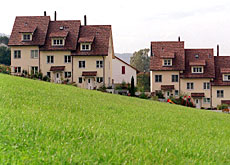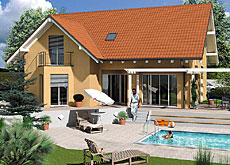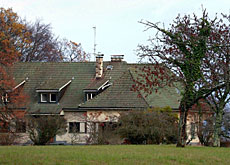Swiss home ownership increases steadily

Favourable conditions in the housing market are making home ownership a more viable prospect for Swiss families.
Buying a house has long been out of reach for many Swiss but low interest rates and reasonable prices are changing the status quo, analysts say.
Although Switzerland lags far behind other European countries in home-ownership rates, the proportion of owner-occupiers is increasing steadily.
Between 1990 and 2000, the percentage of owner-occupiers increased from 30.3 to 34.6 per cent. It is now estimated to be around 36.5 per cent.
Mortgage consultant Lorenz Heim of the mortgage centre Hypotheken Zentrum predicts the rate will continue to rise. “I come across more and more younger people looking to buy property because they see that mortgage repayments are cheaper than rent.”
Demographics are also playing a part in the ongoing demand for property. The biggest group of buyers is in the 35-45 age bracket, followed by those in their late twenties and early thirties. This “settling-down” population segment will continue to grow in numbers for some time.
Increased supply
Following a tendency of decreasing supply for eight consecutive years, the amount of new housing built in 2003 grew by 11.2 per cent compared with 2002. The housing stock has continued growing since then.
Dieter Marmet of Wüest and Partner property consultancy says supply is rising dramatically. “Around 32,000 houses and apartments were built in 2003, last year it is estimated to be around 36,000 and it will exceed 40,000 this year.”
The most popular housing type is condominiums – owner-occupied apartments – and there are more multi-unit than single-unit buildings available on the market.
Of last year’s construction permits, a third were for single-family dwellings and two-thirds for apartment blocks. In 2004, the average price rise in the single-family dwelling market was 2.1 per cent.
Buying beats renting
Some commentators believe that, for those who can afford it, it is now more viable to buy than to rent. Low interest rates play an important part in the equation.
Credit Suisse economist Ulrich Braun explains: “At the moment we have historically low levels of interest rates. So if you want to finance your home, now is the best time we have seen for the last 30 to 40 years.”
However Marmet points out that interest rates change and they will almost certainly go up over the term of the loan.
“You have to ask yourself if you can still afford the mortgage repayments after rates have gone up. It is important when buying a house to calculate with the long-term average.”
Easier to borrow
The banks are going further to lend money in this low-interest climate. Traditionally buyers needed to put up 20 per cent of their own money to purchase a property. Banks were unwilling to accept a loan-to-value ratio of more than 80 per cent.
But now it is increasingly possible to secure a mortgage with fewer savings.
“It is also possible to use pension funds as additional security, bringing the loans up to 100 per cent in some cases,” says Heim.
Marmet believes that a certain proportion of renters could afford to buy but choose to rent. “One reason for this is that there is a really well-functioning rental market and you can find decent apartments for decent prices.”
Bad memories
The residential market underwent a severe correction in the second half of the 1990s and price levels today have not reached the peak levels before the crash. This experience has left its mark on the sector.
The average single-family dwelling is currently selling at 15 per cent below prices paid in the peak year of 1990.
However Braun is confident that times have changed. “The economic conditions are completely different now compared with the late 1980s. The Swiss economy was growing at four to five per cent at the time, we had high inflation rates and high interest rates.”
“What we have now is growth rates of 1.3 to 1.5 per cent, low interest rates and relatively low inflation. Therefore there is no reason why there should be a crash or correction in the short to medium term.”
In 2000 the Swiss home-ownership rate was 34.6 per cent, up from 30.3 per cent in 1990.
The rate is now estimated to be around 36.5 per cent.
This compares with 43 per cent in Germany, 55 per cent in France and 56 per cent in Austria.
The biggest group of buyers is in the 35-45 age bracket.
The amount of new housing built in 2003 grew by 11.2 per cent compared with 2002.

In compliance with the JTI standards
More: SWI swissinfo.ch certified by the Journalism Trust Initiative



You can find an overview of ongoing debates with our journalists here. Please join us!
If you want to start a conversation about a topic raised in this article or want to report factual errors, email us at english@swissinfo.ch.